Bhutan is now fighting against the spread of deadly virus by closing down the schools and institutions, government distributing free face mask and hand sanitizer, creating awareness at all levels of the people, building numerous flu clinic in all regions, and citizens at all level volunteering to help contain the virus and stop spreading. Bhutan is fully prepared to contain and mitigate the spread of the deadly virus called COVID - 19.
Details of The Daily Program of Thimphu Festival
One of the most celebrated Festivals of Bhutan is the Thimphu Tshechu or the Thimphu Festival. The Thimphu Tshechu is performed at the Tendrel Thang, the performing courtyard adjacent to the spectacular and magnificent Tashi Chho Dzong or the Fortress of Glorious Religion.
Tshechus or Bhutan Festivals are one of the most important mega events in the country and equally anticipated and enjoyed by both the Bhutanese and visiting tourists alike. It is festive, colorful and a time to socialize and feast with your loved ones. Bhutanese people dressed in their finest attires and embellishments attend these festivals, an eye fest for the tourists of both the colorful festival and the equally colorful Bhutanese people. Tshechus comprise of various masked dances and traditional/modern Bhutanese songs and dances (not much of modern though). The mask dances are performed by monks and often play out mythical and legendary stories and as is the norm, all the dances have spiritual and historical significance. All the Tshechus are held in the courtyard of the Dzongs (mighty fortresses) and Monasteries and it is said that witnessing a masked dance will bless and cleanse us of all our sins!!!
The sacred masked dances are based mostly on incidents from the life of Guru Rinpoche or Padmasambhava, the Lotus Born. Guru Rinpoche is the patron saint who introduced Buddhism to Bhutan, Tibet and the surrounding region. The various masked dances depict the subduing and subjugation of demons (Obstacles to the Dharma), celebrates the triumph of good over evil and the dances of the heavenly saints and angels in Zangdopelri, the Glorious Copper Colored Mountain Paradise of Guru Rinpoche.
The most popular and of the highest religious significance are the Guru Tshengye or the Dance of the Eight Manifestation of Guru Rinpoche, Shaw Shachi or the Dances of Stags, and the Bardo or the Dances of the Lord of Death and many more, all of which are enjoyed as they are like in a stage or a theatre.
First initiated in 1867 by the 4th Druk Desi, the then secular leader of Bhutan, Thimphu Tshechu consisted of few dances strictly performed by monastic monks. Today the Tshechu is celebrated for three consecutive days of colorful masked dances and traditional songs and dances. In addition to the masked dances performed by the monks are the Boed Chams of equal religious significance and grandeur performed by lay men and farmers.
Perhaps, the most favored of all during the festivals are the Atsaras or the clowns that entertain the crowds all day long. Always found carrying a wooden or cloth phallus, they are free to imitate any of the dancers, impersonate religious saints, and make hilarious and at times vulgar jokes. But the Atsaras are actually learned saints and high lamas who have already attained enlightenment. They are regarded as teachers and during the festival they guide the masked dancers on the ground should anything go wrong or if their costumes and masks need to be adjusted. As in the legends where teachers transform themselves in many forms, being a clown is one of their many manifestations to correct and guide their students herein in a light manner!
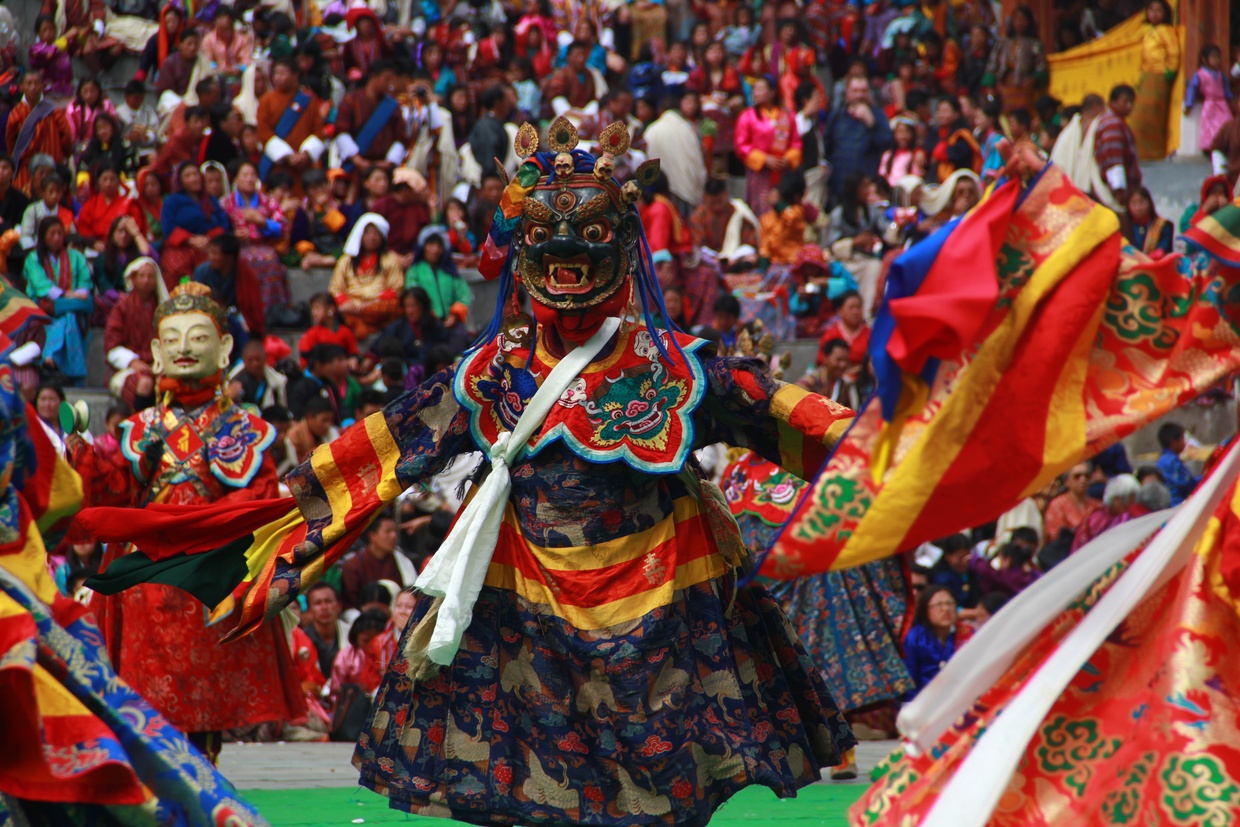 Detail programme and brief description of the Thimphu Tshechu:
Detail programme and brief description of the Thimphu Tshechu:
DAY 1
Dance of the Four Stags (Shazam Cham)
Costume: knee length skirts and horned deer masks.
Religious origin and explanation: This dance represents Guru Rinpoche’s subjugation of the God of Wind, who oppressed the world and all sentient beings dwelling in it. Guru Rinpoche rode his victim’s mount, a stag, and appeased all beings by re-establishing peace and happiness in the world. During this dance the gratitude of the pious people is demonstrated to all beings destined to be converted in the future.
Dance of the Three Kings of Ging with Sticks, Swords and Drums (Nye-ley mi Cham)
Costume: Knee-length skirts and masks of different animals. The dancers hold sticks, swords and drums.
Religious origin and explanation: This is a visual representation of the subduing of the demons by the Three Kings of Ging who are emanations of the Guru Rinpoche, as seen and visualized by the great Terton (treasure discoverer) Pema Lingpa (1450-1521) during his visit to Zangdopelri (paradise of Guru Rinpoche).
The demons may flee anywhere in the Three Worlds but the Ging with the sticks find them, catch them with the hook of compassion, beat them with the stick of wisdom and tie them with the noose of compassion. The sword-wielding Ging sends the minds of the demons to the paradise of pure consciousness and use the bodies of the demons as sacrificial offerings. After that, the Ging with the drums dance with happiness, their drums propagating religion, luck and happiness to all living beings.
Dance of the Hero (Pacham)
Costume: Yellow skirts and golden crowns. No masks. Dancers hold bells and drums.
Religious origin and explanation: It was at Zangdopelri that Pema Lingpa witnessed Guru Rinpoche sitting among his assistants in the center of a limitless Mandala (mystic geometric figure) of rainbows. Within this Mandala, a congregation of the sages, the tutelary deities, the heroes (Pawos) and the heroines (Khandom Pamo) dance in the form of various emanations of peaceful and terrifying deities. The assembly of the peaceful heroes and heroines is the most important. Their function is to lead the dead out of this world and into the presence of Guru Rinpoche.
Dance of the Stags and the Hounds (Shawo Shachi)
Costume: Dog and stag mask with knee-length yellow skirts
Religious origin and explanation: Generally staged as a play in two parts this dance represents the conversion of a hunter Gonpo Dorji, to Buddhism by the great Tibetan saint Jetsun Milarepa (1040-1123).
Once, while in meditation, Milarepa heard a man shouting and a dog barking. Upon coming out of his cave he saw a red stag sweating and trembling with fear. Milarepa sang a religious song that caused the stag to forget fear and lie down on his right. Chasing the stag, a red dog, evidently fiery with wrath, appeared. It succumbed to the pacifying effect of Milarepa’s song just as easily and lied down on his left. Then comes the frighteningly fierce hunter Gonpo Dorji, carrying a bow and arrows. Enraged at the sight of Milarepa and the two animals at peace, he shot a poisonous arrow at the saint. Gonpo Dorji’s bow broke into pieces, the sting of the bow snapped and his arrow turned back towards him. Milarepa then sang another song that filled Gonpo Dorji with a violent regret for all wrongful actions he had committed before. Then the hunter took an oath not to commit any sort of sin again, embraced religion, and eventually attained full realization.
The first part of this dance is somewhat comical. The hunter’s servant appears and jokes with the clowns. Then comes the hunter crowned with leaves and carrying a bow and arrows. He is accompanied by two dogs (instead of one). The servant jokes with the atsaras (clowns) and his master, who performs pre-hunting rituals in a way contrary to the Buddhist tradition.
Dance of the Guitar (Dranyen Cham)
Costume: Elaborate and heavy woolen clothes, traditional felt boot, long black skirt, yellow shirt, brown coat, sword and circular headdress. One dancer holds a dranyen (guitar).
Religious origin and explanation: This is a cheerful dance that celebrates the establishment and diffusion of the Drukpa School of Buddhism in Bhutan by Zhabdrung Ngawang Namgyel (the Saint who unified Bhutan). Zhabdrung brought under his control the large Southern Land of Four Approaches (Lhomen Kha Zhee) as Bhutan was once known, and blessed it. He protected his subjects by the heavy golden yoke of law and order and vanquished many foreign enemies. He built the Dzongs (fortress), grand temples, chhortens (stupas) and wrote religious books.
Day 2 (The Tshechu starts from this day)
Dance of the 21 Black Hats (Zhana Nyerchig Cham)
Costume: Large black hats, felt boots, long colorful brocade gowns, no masks.
Religious origin and explanation: This ground purification rite is also performed on the occasions of construction of fortresses, temples, and stupas to conciliate the malevolent beings of the ground and take possession of the site from them.
The black hat dancers assume the appearance of yogis who show great and passionate anger externally but actually have accomplished peaceful minds. They possess the power of killing and recreating life. They subdue and liberate beings that cannot be led by peace. The five poisonous enemies, which are the sins, disappear in the sphere of emptiness.
This dance is also referred to as “Gar” dance. It is derived from the different traditions of the Tantras (text of northern Buddhism). It is said that with the help of the Gods who have meditated deeply upon the Mantras (sacred formulae) the “Gar”, which are the gestures of the dancers’ hands, transform into mudras (sacred mystic gestures) and their feet, which pound the earth, form a mandala (mystic geometric figure). The Black Hat dancers performing the ritual, build a mandala, and cut the demons into pieces. They thus safeguard the earth and dance the step of the thunderbolt to impress their power on it.
Dance of the 21 Black Hats with Drums (Zhana Nga Cham Nyerchig)
Costume: Large black hats, drums, felt boots, long colorful brocade gowns, no masks.
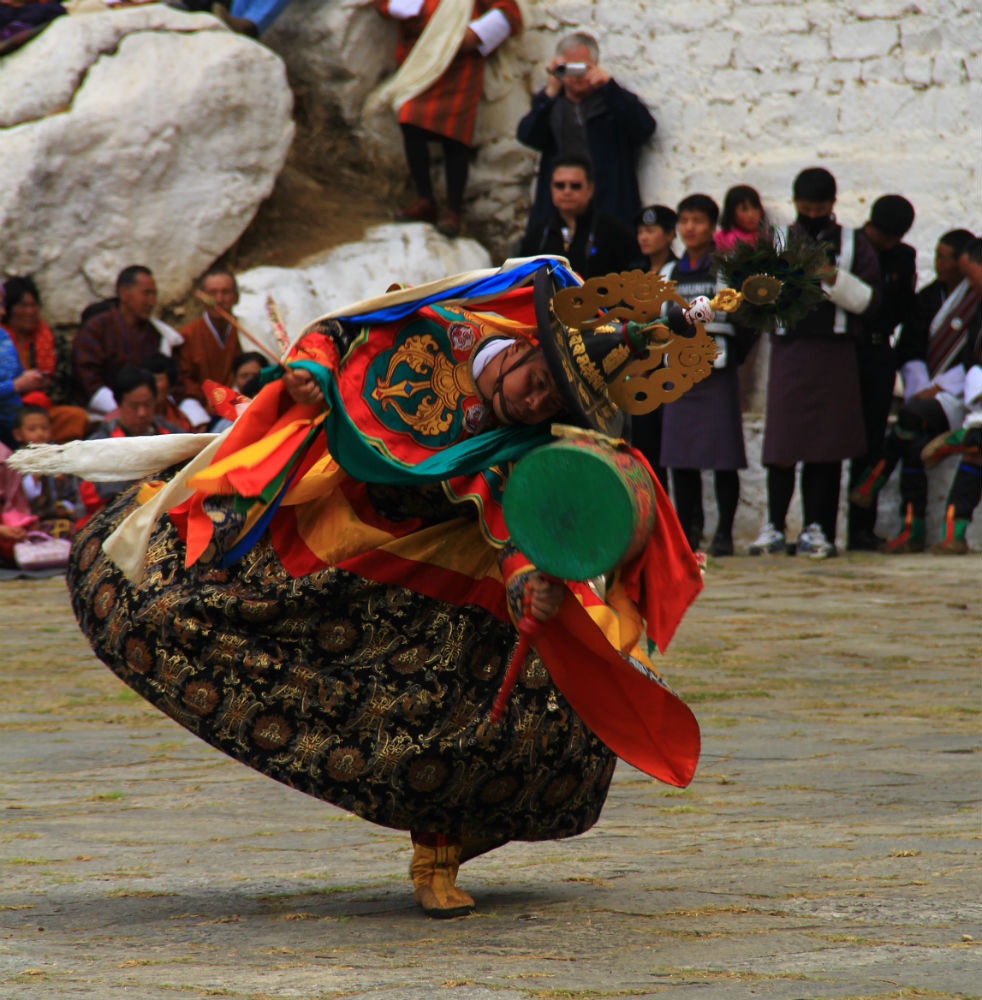 Religious origin and explanation: The Black Hat dancers beat the drums, the sound of which resounds throughout the Three Worlds in honour of the victory of religion over their enemies and the destruction of malevolent spirits. The drum sounds represent the Dharma itself, which cannot be represented in any other way because it has no visible form.
Religious origin and explanation: The Black Hat dancers beat the drums, the sound of which resounds throughout the Three Worlds in honour of the victory of religion over their enemies and the destruction of malevolent spirits. The drum sounds represent the Dharma itself, which cannot be represented in any other way because it has no visible form.
The Accompaniment DanceThe (Kay Cham)
Costume: Knee-length yellow skirts, bare-feet, animal masks, swords in right hand.
Religious origin and explanation: When King Norzang of a north Indian valley called Naden left to subdue enemies further north, the protectors and guardians of the doctrine and the assembly of the king’s tutelary deities were his armed companions. This is the classical explanation of this dance, hence its name.
One other explanation is related to another dance, the Pholey Moley. This version talks of a once compatible couple whose marriage, when shaken by the trials of a love triangle, ends with the husband cutting off his wife’s nose. The story reinforces the universal law that says there is no real substance in worldly components. Many people behave similarly and bring upon themselves sufferings in their lives. Faith in the Buddhist creed, on the other hand, allows one to realize happiness from knowing that the three jewels (Buddha, Religion, and Community of Believers) are sanctuaries that never fail.
Dance of the Nobleman and the Ladies (Pholey Moley)
Costume: Rich clothes and jewelry
Religious origin and explanation: Like the one that precedes it, this dance draws from the biography of King Norzang of Naden in the North of India and continues the themes of fidelity tested by physical distance and mutilation. King Norzang’s northern crusade separated him from Yidrogma, his favorite queen. His eventual return, though, sees an ending reminiscent of the Odysseus- Penelope reunion.
What really happens in the dance is closer to a comical play than a dance. Two princes go to war, leaving behind two princesses in the care of an old couple. As soon as they depart, teams of clowns frolic with the princesses and corrupt the old woman who behaves immorally as well. Upon returning from war the princes are scandalized by the behavior of the princesses and the old woman and cut off their noses as punishment. A doctor is called to put the noses back but the old woman stinks so much that the doctor has to use a stick to do the job. Finally the princes marry the princesses and everybody is reconciled.
Dance of the 16 Drum Beaters from Dramitse (Dramitse Ngacham)
Costume: Colorful dress with mask of lion, garuda, snake, dragon, raven, owl, yak, tiger, pig, leopard, sheep, bat, bear, dog, goat and ox.
Religious origin and meaning: The learned Lam Kuenga Gyeltshen had, like Terton Pema Lingpa before him, a vision of Guru Rinpoche and his Paradise. He saw the attendants of Guru Rinpoche transform into a hundred peaceful and terrifying deities. They danced with big drums in their left hands and drumsticks in their right hands. Lam Kunga Gyeltshen depicted this vision in this dance, which he composed in the Eastern Bhutanese monastery of Dramitse.
The pensive and serene dance signifies peaceful deities and fast and sporty dance, the wrathful deities, who aim to subdue the evil spirits. This dance is proclaimed as a masterpiece of oral intangible cultural heritage of humanity by UNESCO.
Dance of the Stags and the Hounds (Shawo Shachi)
Costume: Dog and stag mask with knee-length yellow skirts
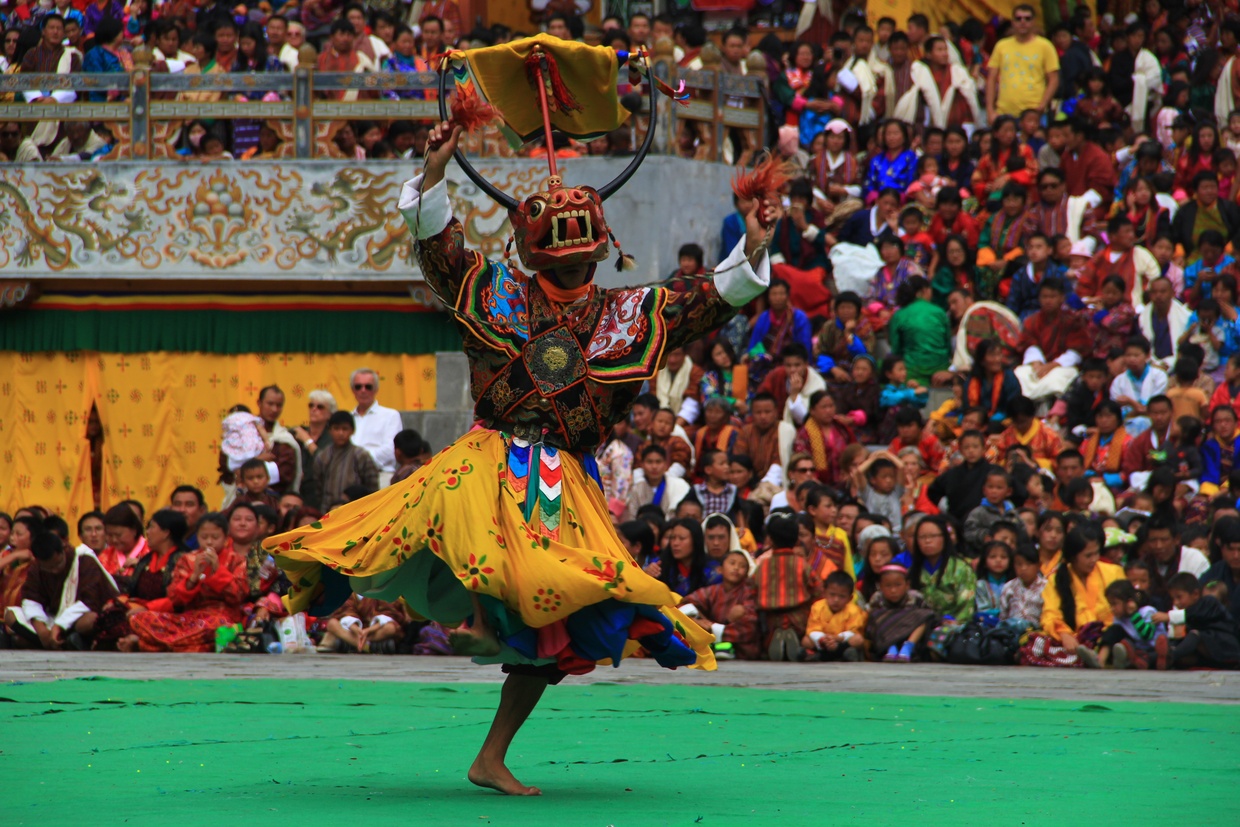 Religious origin and explanation: Generally staged as a play in two parts this dance represents the conversion of a hunter Gonpo Dorji, to Buddhism by the great saint Jetsun Milarepa (1040-1123)
Religious origin and explanation: Generally staged as a play in two parts this dance represents the conversion of a hunter Gonpo Dorji, to Buddhism by the great saint Jetsun Milarepa (1040-1123)
Once, while in meditation, Milarepa heard a man shouting and a dog barking. Upon coming out of his cave he saw a red stag sweating and trembling with fear. Milarepa sang a religious song that caused the stag to forget fear and lie down on his right. Chasing the stag, a red dog, evidently fiery with wrath, appeared. It succumbed to the pacifying effect of Milarepa’s song just as easily and lied down on his left. Then came the frighteningly fierce hunter Gonpo Dorji, carrying a bow and arrows. Enraged at the sight of Milarepa and two animals at peace, he shot a poisonous arrow at the saint. Gonpo Dorji’s bow broke into pieces, the sting of the bow was cut and his arrow turned back towards him. Milarepa then sang another song that filled Gonpo Dorji with a violent regret for all wrongful actions he had committed before. Then the hunter took an oath not to commit and sort of sin again, embraced religion, and eventually attained full realization.
The first part of this dance is somewhat comical. The hunter’s servant appears and jokes with the clowns. Then comes the hunter crowned with leaves and carrying a bow and arrows. He is accompanied by two dogs (instead of one). The servant jokes with the atsaras (clowns) and his master, who performs pre-hunting rituals in a way contrary to the Buddhist tradition.
The second part has a more serious and religious tone. Milerapa appears wearing a long white dress, a white hat and holds a pilgrim’s staff. He sings with a soft voice and has his right hand near his ear. The stag, the two dogs and the hunter, one after the other, arrive before Milerapa and he converts them with his song. The rope that the hounds and the hunter have to jump over symbolizes the conversion.
Day 3
Dance of the Lords of the Cremation Grounds (Durdag Cham)
Costume: White short skirts, white boots, white skull masks.
Religious origin and explanation: On the external edges of a symbolic Mandala where the assembly of the sacred tantric deities reside, there are eight large cremation grounds. Among the numerous living protectors of the religion (Chhokyong), the Lords of the Cremation Grounds are bound by an oath to protect the dharma from its demonic enemies. They also protect the grounds. The Lords render the demons powerless, offer them to the gods of the mandala and reduce them to mere name.
Dance of the Terrifying Deities (Tung Ngam Cham)
Costume: Beautiful brocade dresses, boots and terrifying masks.
 Religious origin and explanation: This dance is intended to deliver all sentient beings by showing them the Zangdopelri, the paradise of Guru Rinpoche. Here Guru Rinpoche takes the fiery form of Dorji Dragpo (The Fierce Thunderbolt) because it is the only alternative to liberating the men and demons that oppose Buddhism. The dramatic dance has a very deep symbolic meaning. The dancers representing the gods enclose the evil spirits in a circle and in a box after which the god who holds the phurba, the ritual dagger, kills them. He thus saves the world from them and at the same time delivers them into salvation.
Religious origin and explanation: This dance is intended to deliver all sentient beings by showing them the Zangdopelri, the paradise of Guru Rinpoche. Here Guru Rinpoche takes the fiery form of Dorji Dragpo (The Fierce Thunderbolt) because it is the only alternative to liberating the men and demons that oppose Buddhism. The dramatic dance has a very deep symbolic meaning. The dancers representing the gods enclose the evil spirits in a circle and in a box after which the god who holds the phurba, the ritual dagger, kills them. He thus saves the world from them and at the same time delivers them into salvation.
Dance of the Rakshas and the Judgement (Raksha Mangcham)
Costume: Knee length yellow skirts, colored jackets, animal masks
Religious origin and explanation: Raksha Mangcham or the Dance of the Judgement of the Dead is based on the Bardo Thaydrel (Book of the Dead), a text hidden by Guru Rimpoche and rediscovered later by Terton Karma Lingpa in the 14th century.
According to the Bardo ThaydrDael, when living beings die they wander in Bardo (state between one’s death and rebirth). The Buddhas during that period manifest themselves into different forms and assemble to carry out justice on the dead beings according to their deeds in their previous lives. While appearing in front of the Lord of Death, those beings that have lived their lives according to the doctrine are rewarded. On the other hand sinners and non-believers of the doctrine have to pass through the abysmal Bardo. For their sins, they face rebirth in different Hells where they are tormented by the terrifying deities. These sinners have to endure their sentence till they are purified of all their sins and finally gain their proper rebirth. The sentence may be spread over hundreds of years depending on the type of sin.
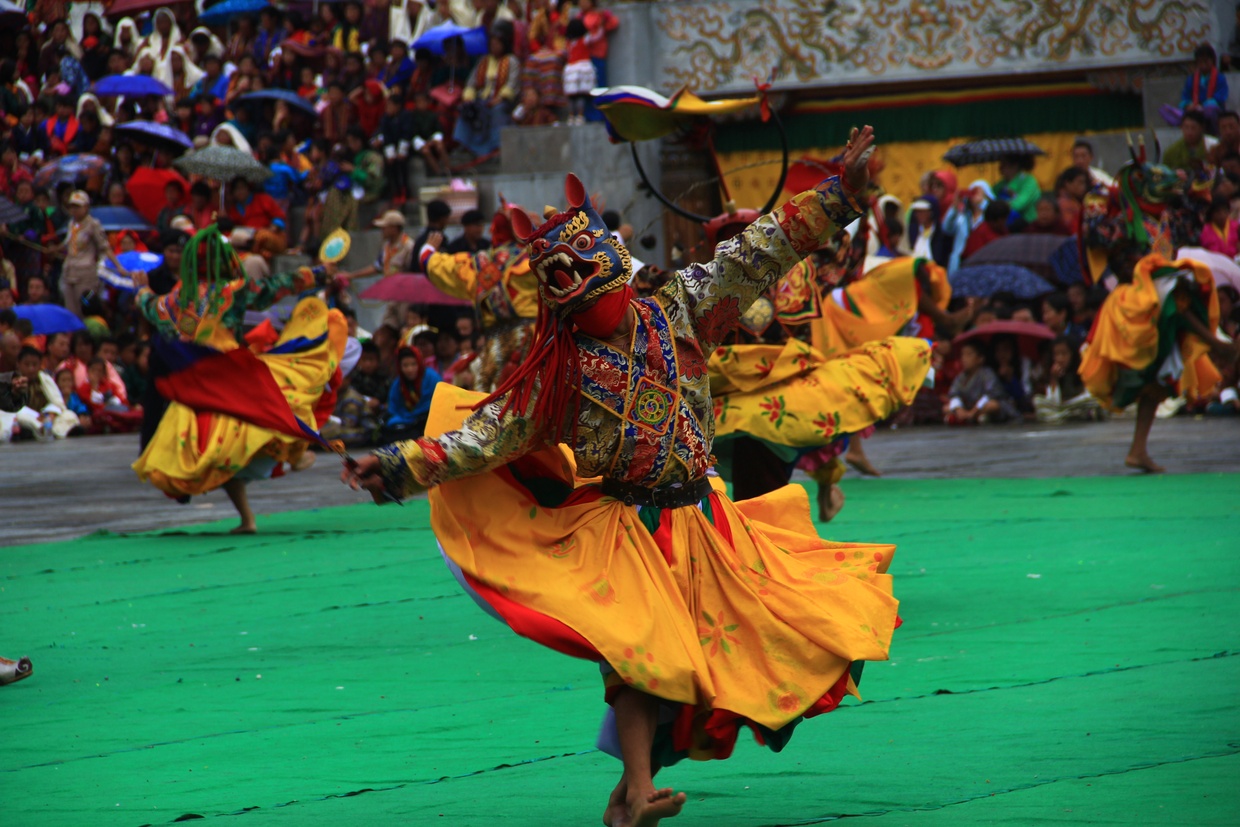 The judgments given depend on the different life styles in their previous lives. The judgments by the assembly of Buddhas are dramatized through the Raksha Mangcham. The Buddhas manifest themselves into the Shinje ChoekiGyap (Lord of Death), Lhakaap (white god), Dre Nagchung (black demon), Raksha Lango (the ox-headed justice minister) and other deities wearing masks of different birds and animals.
The judgments given depend on the different life styles in their previous lives. The judgments by the assembly of Buddhas are dramatized through the Raksha Mangcham. The Buddhas manifest themselves into the Shinje ChoekiGyap (Lord of Death), Lhakaap (white god), Dre Nagchung (black demon), Raksha Lango (the ox-headed justice minister) and other deities wearing masks of different birds and animals.
Raksha Mangcham is considered very special and it is believed that a person is partly purified from his or her sins every time he or she witnesses the dance. The main purpose of the dance is, however, to remind people to lead good lives so that they are delivered from the terrifying Bardo and are able to have happier times in their next lives.
During an interval people offer their relatives alcohol against money, which is a way of wishing each other prosperity and good luck. After this the dance is resumed.
Day 4
Dance of Tamshing in Bumthang (Bumthang Tercham)
Costume: Knee-length yellow skirts, white mask, a little bell and drum in hand
Religious origin and explanation: The great treasure discoverer Terton Pemalingpa built the temple of Lungrub Chholing at Tamshing in Bumthang Valley. Some time before its consecration, the saint saw a dream in which five Tantrist brothers from the Lord of Sufferings of the three worlds instructed him to consecrate the temple with a special dance that they performed. Upon waking up Pema Lingpa set about composing the dance using his recent memory of the dream as well as a text called Phurba Segi Poti.
Dance of the Lords of the Cremation Grounds (Durdag Cham)
Costume: White short skirts, white boots, white skull masks.
Religious origin and explanation: On the external edges of a symbolic mandala where the assembly of the sacred tantric deities reside, there are eight large cremation grounds. Among the numerous living protectors of the religion (Chhokyong), the Lords of the Cremation Grounds are bound by an oath to protect the dharma from its demonic enemies. They also protect the grounds. The Lords render the demons powerless, offer them to the gods of the mandala and reduce them to mere name.
Dance of the Ging and Tsholing (Ging Tsholing)
Costume: The Tsholing wear long colourful dresses and masks. The Ging wear orange skirts that hang like a skin, terrifying black and orange masks with flags on top, and carry big drums.
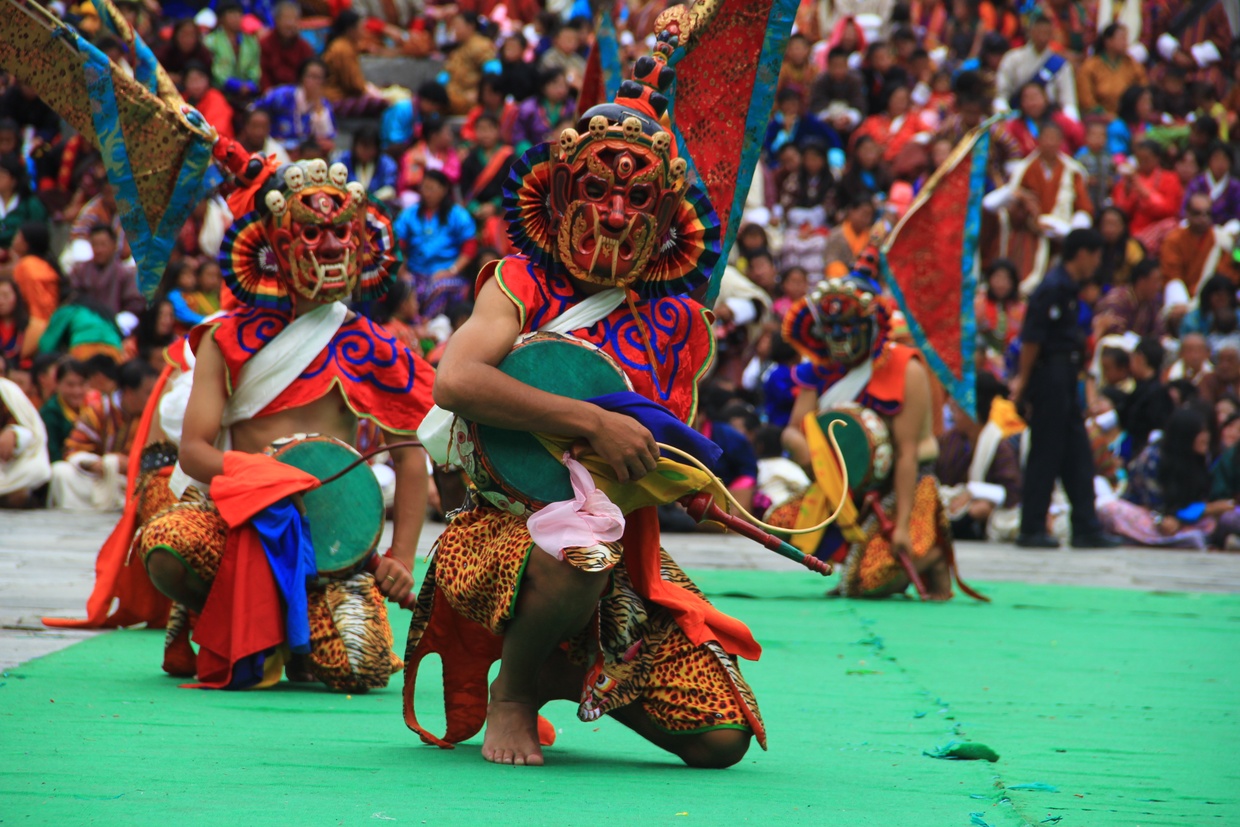 Religious origin and explanation: Guru Rinpoche initiated the dance on the occasion of the consecration of the Samye Monastery in Tibet in order to show to the people of Tibet his paradise or Zangdopelri. All the protectors of the religion, male and female in their fierce forms guard the four outer doors while the four guardian kings of the directions command an army of the eight classes of spirits. These subdue all the demons, enemies such as devilish heretics that create obstacles to the Doctrine of Buddha.
Religious origin and explanation: Guru Rinpoche initiated the dance on the occasion of the consecration of the Samye Monastery in Tibet in order to show to the people of Tibet his paradise or Zangdopelri. All the protectors of the religion, male and female in their fierce forms guard the four outer doors while the four guardian kings of the directions command an army of the eight classes of spirits. These subdue all the demons, enemies such as devilish heretics that create obstacles to the Doctrine of Buddha.
An assembly of heroes (Pawos), tutelary deities perform the inner dance, called the Ging. The outer dance, called Tsholing, is performed by the protectors of the religion with their retinue of eight classes of spirit. This dance is performed in order to remove obstacles to the doctrine just as it is a dance of purification before the arrival of Guru Rinpoche in the following dance. People whistle to chase away the bad spirits and the Ging hit people on the head with their drumsticks to chase impurity out of their bodies. The Tsholing dancers, after having destroyed the evil spirits symbolized by an image in a black box, are chased away by the Ging. The Ging dancers stay behind and perform the dance of victory by beating the drums.
Dance of the 8 Manifestations of Guru Rinpoche (Guru Tshen Gye)
Costume: Colorful dresses and masks
Religious origin and explanation: This dance shows the eight different forms that Guru Rinpoche assumed in order to bring different beings into the Buddhist fold:
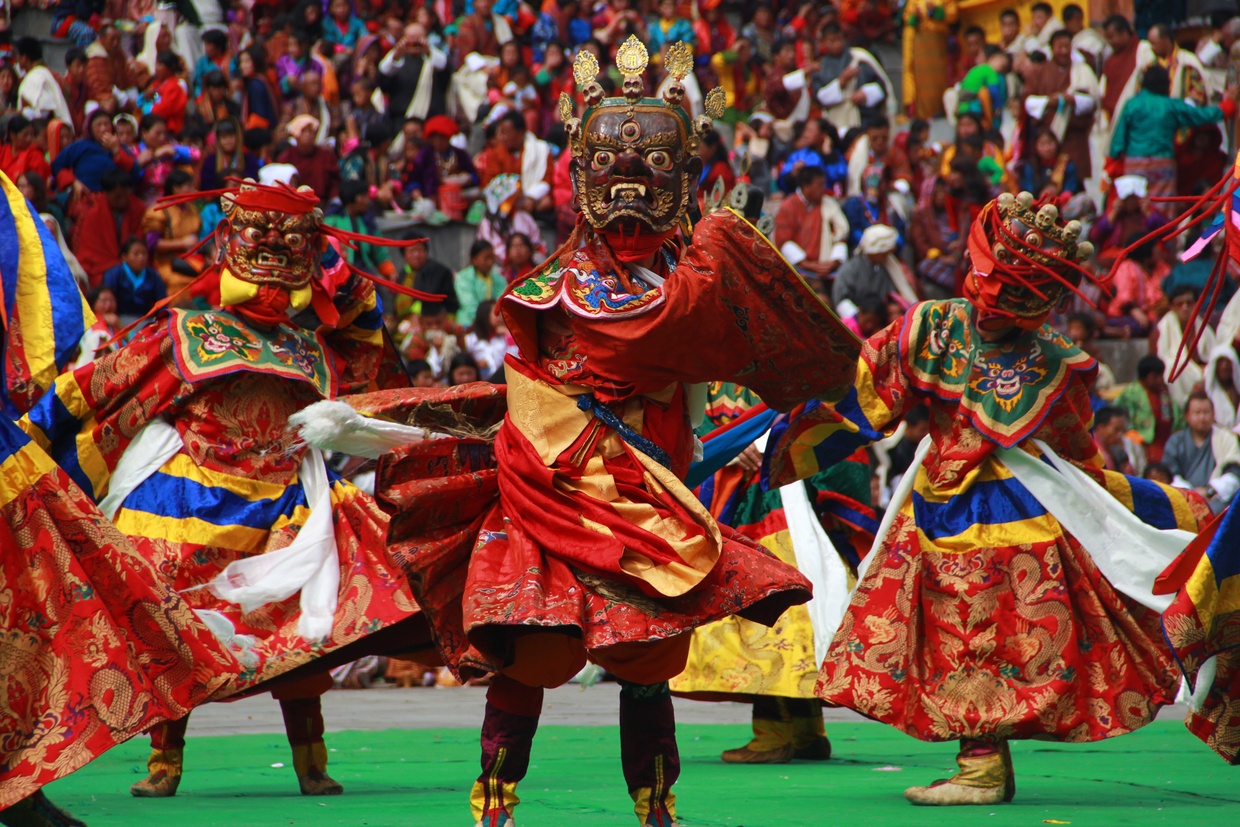 Guru Tshokye Dorji (Diamond Thunderbolt Born from the Lake).
Guru Tshokye Dorji (Diamond Thunderbolt Born from the Lake).
Guru Shakya Senge (The Lion of the Shakya Clan).
Guru Loden Chogsey (Guru who Aspires for the Supreme Knowledge)
Guru Padmasambhava (Lotus Born)
Guru Pema Gyalpo (Lotus-king)
Guru Nima Yeoser (Sun Beam)
Guru Senge Dradok (The One Who Speaks With a Lion Voice)
Guru Dorji Dragpo (Terrifying Thunderbolt) and Guru Dorje Drolo (Thunderbolt).
The angel standing on the right of the Guru is Mandarava, the Lady of Wisdom. Guru Rinpoche made her his own emanation for the benefit of the beings to be converted in the Kingdom of Zahar. The angel to his left is Yeshey Tshogyel. She is a representation of the Goddess of Knowledge, mother of all the Buddhas. She helped to establish Buddhism in Tibet. The Sixteen angels (Rigma Chudrug) are emanations of the same person. They are Goddesses of Offerings.
The Guru Tshen Gye dance is said to bring complete happiness to people. A changeless faith in the glorious deeds of Guru Rinpoche’s mind, speech and body is born to them.
Dance of 16 angels (Rig Nga Chudru)
Costume: Beautiful dresses decorated with minute ivory carvings.
Religious origin and explanation: The Sixteen angels are sixteen emanations of the same person. They are Goddesses of offerings who are divided into four categories. Each category is further divided into four, which makes sixteen. They dance holding drums first, then small hand bells and drums.
This dance brings total and complete happiness. People believe in the manifestations of Ugyen Guru Rinpoche during the dance. A changeless faith in the glorious deeds of Rinpoche’s mind, speech and body are born to them.
Religious Song (Chozhey)
Costume: Very similar to the Guitar Dance. Elaborate and heavy woolen clothes: long black skirts, yellow shirts, folded brown coats, felt boots, circular headdresses and swords.
Religious origin and explanation: Performed to commemorate the opening of the gateway for pilgrimages to Tsari Mountain (Eastern Tibet) by the founder of the Drukpa School, Tsangpa Gyarey (1161-1211).
This dance finds its origin in a story about Tsangpa Gyarey arriving in Tsari to subdue a frog that attempted to block his path by turning itself into a yak and then a rock. It eventually offered him his life force. After establishing the frog as the guardian deity of the place, the saint opened the gateway to pilgrims. Believers take pilgrimages to Tsari to this day.
Further Reading
Either Day-Hike or Over Night Camp with a moderate Bhutan Tour Activities through the Jigme Dorji National Park with a 360 Degree view of snow capped Himalayan Bhutan Mountains.
Each village, community and district celebrate the Tshechu in their various style and fashion – however the main theme is same everywhere with slight variations depending upon the ethnic background, tradition and local myths. The festivals revolve around well choreographed masked dances based mostly on incidents from the life of Guru Rinpoche or Padmasambhava, the saint who introduced Buddhism to Bhutan in the eight century. Witnessing the masked dances is very spiritual...



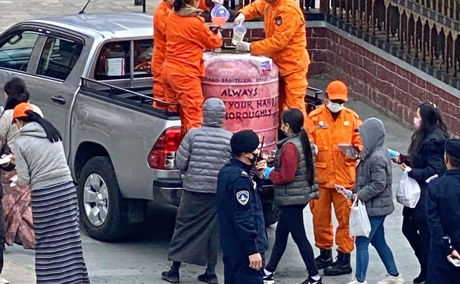
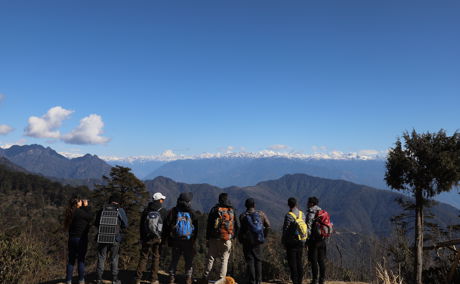
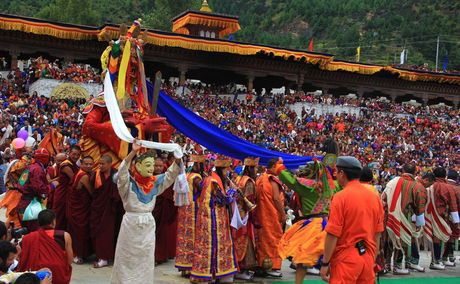
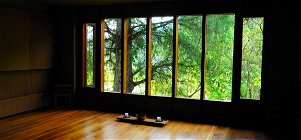
Share This Post